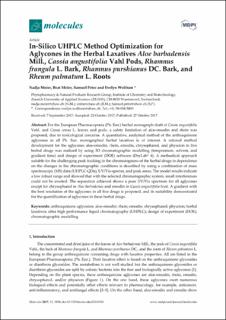Bitte benutzen Sie diese Kennung, um auf die Ressource zu verweisen:
https://doi.org/10.21256/zhaw-3479| Publikationstyp: | Beitrag in wissenschaftlicher Zeitschrift |
| Art der Begutachtung: | Peer review (Publikation) |
| Titel: | In-Silico UHPLC method optimization for aglycones in the herbal laxatives aloe barbadensis Mill., Cassia angustifolia Vahl Pods, Rhamnus frangula L. Bark, Rhamnus purshianus DC. Bark, and Rheum palmatum L. Roots |
| Autor/-in: | Meier, Nadja Meier, Beat Peter, Samuel Wolfram, Evelyn |
| DOI: | 10.21256/zhaw-3479 10.3390/molecules22111838 |
| Erschienen in: | Molecules |
| Band(Heft): | 22 |
| Heft: | 11 |
| Erscheinungsdatum: | 27-Okt-2017 |
| Verlag / Hrsg. Institution: | MDPI |
| ISSN: | 1420-3049 1433-1373 |
| Sprache: | Englisch |
| Schlagwörter: | Aloe-emodin; Anthraquinone aglycones; Chromatographic modelling; Chrysophanol; Design of experiment (DOE); Emodin; Herbal laxatives; Physcion; Rhein; Ultra high performance liquid chromatography (UHPLC) |
| Fachgebiet (DDC): | 615: Pharmakologie und Therapeutik 660.6: Biotechnologie |
| Zusammenfassung: | For the European Pharmacopoeia (Ph. Eur.) herbal monograph draft of Cassia angustifolia Vahl. and Cassia senna L. leaves and pods, a safety limitation of aloe-emodin and rhein was proposed, due to toxicological concerns. A quantitative, analytical method of the anthraquinone aglycones in all Ph. Eur. monographed herbal laxatives is of interest. A rational method development for the aglycones aloe-emodin, rhein, emodin, chrysophanol, and physcion in five herbal drugs was realized by using 3D chromatographic modelling (temperature, solvent, and gradient time) and design of experiment (DOE) software (DryLab® 4). A methodical approach suitable for the challenging peak tracking in the chromatograms of the herbal drugs in dependence on the changes in the chromatographic conditions is described by using a combination of mass spectroscopy (MS) data (UHPLC-QDa), UV/Vis-spectra, and peak areas. The model results indicate a low robust range and showed that with the selected chromatographic system, small interferences could not be averted. The separation achieved shows a pure UV/Vis spectrum for all aglycones except for chrysophanol in Aloe barbadensis and emodin in Cassia angustifolia fruit. A gradient with the best resolution of the aglycones in all five drugs is proposed, and its suitability demonstrated for the quantification of aglycones in these herbal drugs. |
| URI: | https://digitalcollection.zhaw.ch/handle/11475/1970 |
| Volltext Version: | Publizierte Version |
| Lizenz (gemäss Verlagsvertrag): | CC BY 4.0: Namensnennung 4.0 International |
| Departement: | Life Sciences und Facility Management |
| Organisationseinheit: | Institut für Chemie und Biotechnologie (ICBT) |
| Enthalten in den Sammlungen: | Publikationen Life Sciences und Facility Management |
Dateien zu dieser Ressource:
| Datei | Beschreibung | Größe | Format | |
|---|---|---|---|---|
| molecules-MeierEtal_Insilico.pdf | DOI: 10.3390/molecules22111838 | 1.62 MB | Adobe PDF |  Öffnen/Anzeigen |
Zur Langanzeige
Meier, N., Meier, B., Peter, S., & Wolfram, E. (2017). In-Silico UHPLC method optimization for aglycones in the herbal laxatives aloe barbadensis Mill., Cassia angustifolia Vahl Pods, Rhamnus frangula L. Bark, Rhamnus purshianus DC. Bark, and Rheum palmatum L. Roots. Molecules, 22(11). https://doi.org/10.21256/zhaw-3479
Meier, N. et al. (2017) ‘In-Silico UHPLC method optimization for aglycones in the herbal laxatives aloe barbadensis Mill., Cassia angustifolia Vahl Pods, Rhamnus frangula L. Bark, Rhamnus purshianus DC. Bark, and Rheum palmatum L. Roots’, Molecules, 22(11). Available at: https://doi.org/10.21256/zhaw-3479.
N. Meier, B. Meier, S. Peter, and E. Wolfram, “In-Silico UHPLC method optimization for aglycones in the herbal laxatives aloe barbadensis Mill., Cassia angustifolia Vahl Pods, Rhamnus frangula L. Bark, Rhamnus purshianus DC. Bark, and Rheum palmatum L. Roots,” Molecules, vol. 22, no. 11, Oct. 2017, doi: 10.21256/zhaw-3479.
MEIER, Nadja, Beat MEIER, Samuel PETER und Evelyn WOLFRAM, 2017. In-Silico UHPLC method optimization for aglycones in the herbal laxatives aloe barbadensis Mill., Cassia angustifolia Vahl Pods, Rhamnus frangula L. Bark, Rhamnus purshianus DC. Bark, and Rheum palmatum L. Roots. Molecules. 27 Oktober 2017. Bd. 22, Nr. 11. DOI 10.21256/zhaw-3479
Meier, Nadja, Beat Meier, Samuel Peter, and Evelyn Wolfram. 2017. “In-Silico UHPLC Method Optimization for Aglycones in the Herbal Laxatives Aloe Barbadensis Mill., Cassia Angustifolia Vahl Pods, Rhamnus Frangula L. Bark, Rhamnus Purshianus DC. Bark, and Rheum Palmatum L. Roots.” Molecules 22 (11). https://doi.org/10.21256/zhaw-3479.
Meier, Nadja, et al. “In-Silico UHPLC Method Optimization for Aglycones in the Herbal Laxatives Aloe Barbadensis Mill., Cassia Angustifolia Vahl Pods, Rhamnus Frangula L. Bark, Rhamnus Purshianus DC. Bark, and Rheum Palmatum L. Roots.” Molecules, vol. 22, no. 11, Oct. 2017, https://doi.org/10.21256/zhaw-3479.
Alle Ressourcen in diesem Repository sind urheberrechtlich geschützt, soweit nicht anderweitig angezeigt.